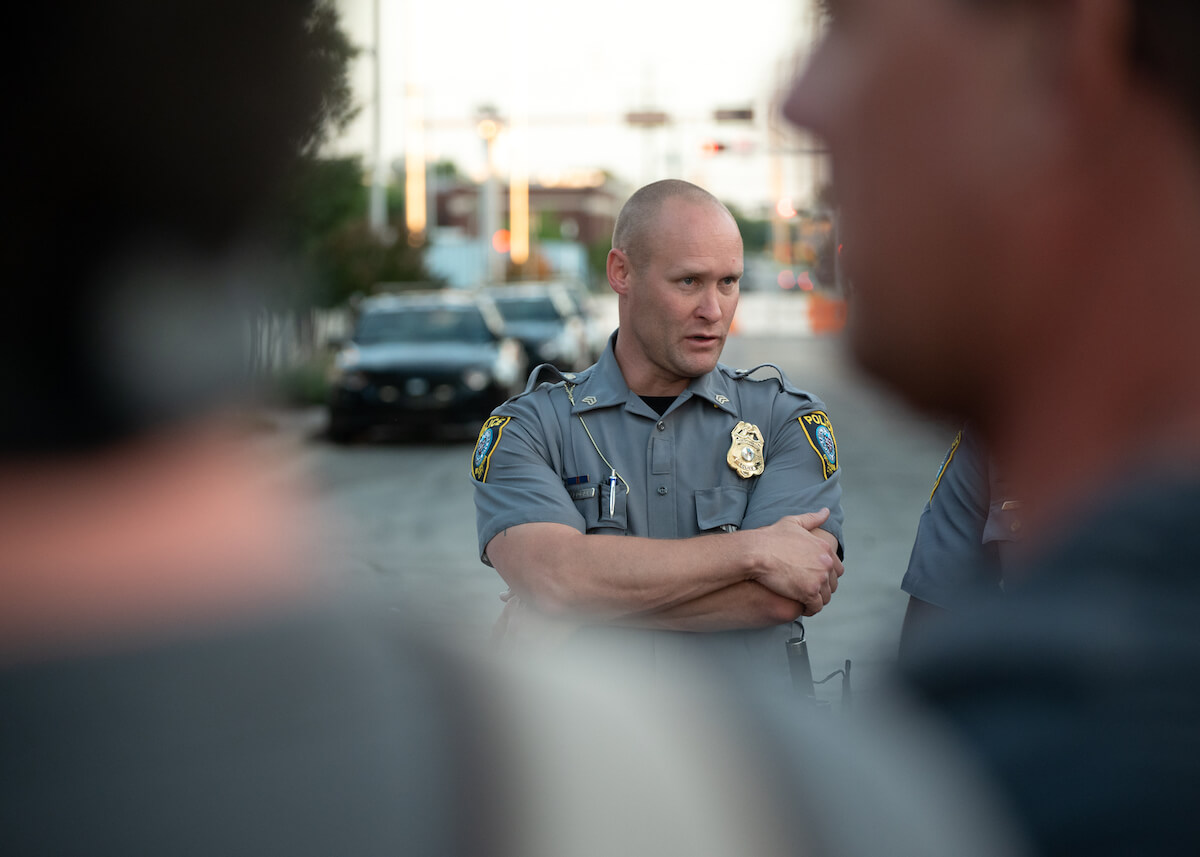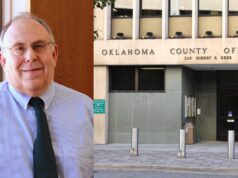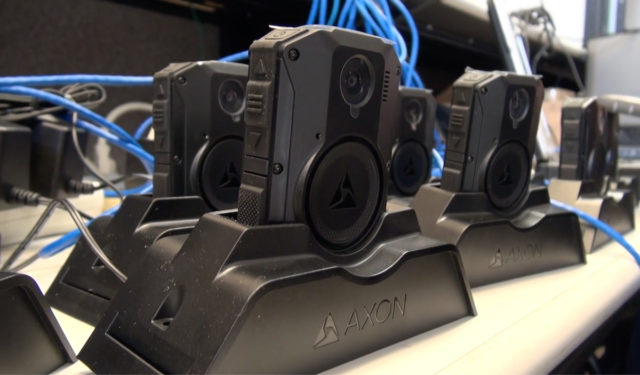
In March, five Oklahoma City police officers were charged with first-degree manslaughter in the shooting death of Stavian Rodriguez, a 15-year-old boy encountered in the process of an armed robbery at a gas station in November 2020. The news came just two weeks after Oklahoma County District Attorney David Prater had also charged another OKCPD officer with manslaughter for shooting and killing Bennie Edwards in December 2020.
In both cases, Prater’s decisions were accompanied by the release of footage from police officers’ body-worn cameras, including ones worn by those charged in the shootings. The graphic videos were instrumental in Prater’s decisions to file charges and have spurred public conversation about the police shootings.
“Body camera video, just like any other type of evidence that we are using now in law enforcement, is very valuable,” Prater said during an interview on the topic. “But you also have to understand that there is limitation to all evidence. (…) It will only see what the camera is pointing at, so you have always got to think about perspective and what you are not seeing off camera.”
Prater, a polarizing figure who has prosecuted several police officers in recent years, said body-worn cameras have helped create “a new day in law enforcement in the review and evaluation of cases where police officers are accused of wrongdoing.”
“The majority of good men and women in law enforcement, they are fine and have no issue with wearing a body camera, because they are out there doing their job the right way,” Prater said. “[The technology] overwhelmingly has cleared officers of alleged misconduct when, generally, the belief by some in law enforcement unions is that it’s just used to discipline or to prosecute police officers. That’s just not true.”
All over the country in recent years, body-worn cameras (or body cams) have become a key tool for building transparency and trust between law enforcement and the public — and for determining what happened after an incident occurs. Oklahoma is no exception, and municipalities around the state have worked to get body cameras up and running in their police departments.
The logic behind body cameras is simple: By recording what police officers do, communities can minimize debates over what actually happened in violent situations. Making a body camera program work the way it should, however, can be more complicated than it looks.
For one thing, a body cam program is not cheap. The cameras themselves can be pricey, but the real shocker is the cost of storing the video footage, which can be prohibitively expensive for some law-enforcement organizations.
Municipalities must grapple with a number of other issues as well, such as when cameras turn on or how long to save footage. Furthermore, many wonder if this purported panacea of accountability is actually making a difference when it comes to violent encounters between the police and the public.
Edmond’s long road to body cameras
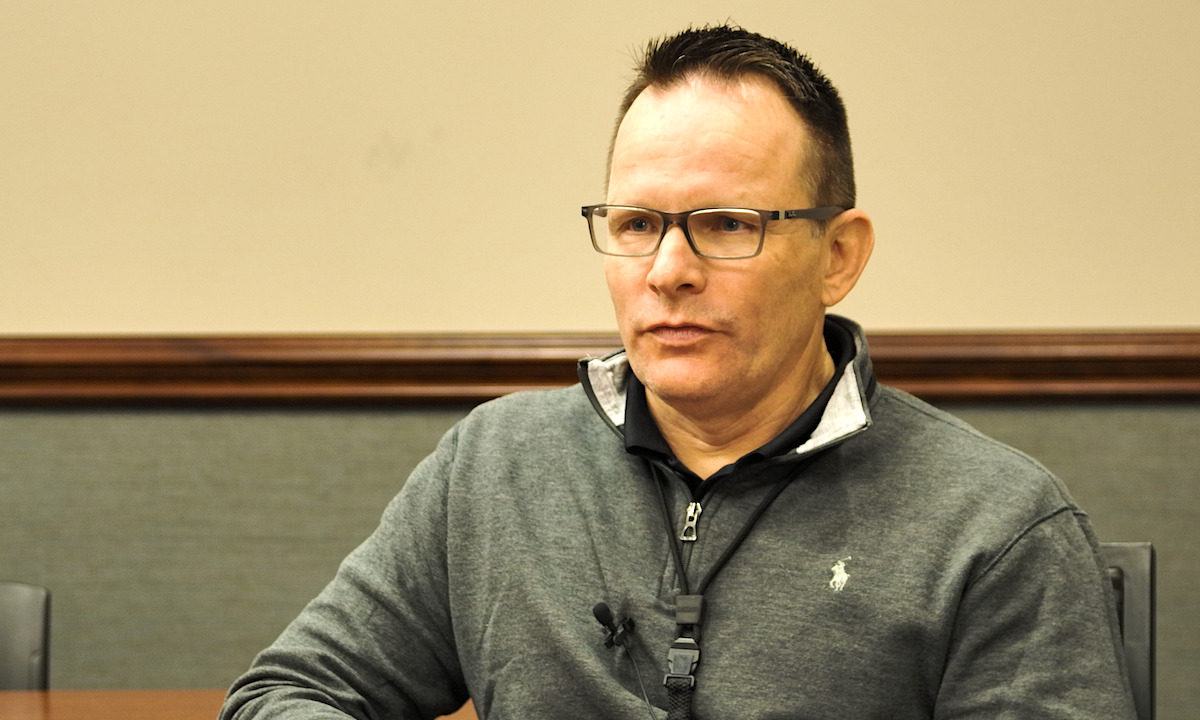
In April 2019, an unarmed teenager named Isaiah Mark Lewis was shot and killed by Edmond police after he entered a stranger’s home and fought with officers while apparently experiencing a psychotic episode. The officers involved were not wearing body cameras, and Prater did not find probable cause to charge them with a crime. Activists maintain that Lewis did not need to die, but no video exists of his fatal encounter with officers.
The shooting happened while the City of Edmond was in the middle of a long, winding effort to equip its police force with body cameras, which started in 2016 and was ultimately fulfilled this spring. The city’s experience provides a case study of the various challenges that come with implementing a body camera program.
“I think it’s a long time coming. Part of it was education, part of it was getting used to it. It’s that way with anything that involves change,” then-Mayor Dan O’Neil told NonDoc in January after the Edmond City Council approved completing EPD’s body cam program. “You would have thought we would have been there a lot sooner. But part of it also was that you’ve got to make it work and find ways of making sure the technology fits and is not too burdensome.”
The city’s first attempt to put cameras on its police officers came at the same time as a national uptick in body-cam use. In 2015, in the wake of the shooting of Michal Brown in Ferguson, Missouri, the U.S. Justice Department even started a program to give grants totaling more than $23.2 million to local law enforcement agencies to expand the use of body-worn cameras and explore their impact.
Edmond did not receive one of these grants, but in 2016 Edmond’s in-car camera vendor introduced a body-worn camera, and the city received 10 units as part of a two-year pilot project. Edmond Chief of Police J.D. Younger said the trial run motivated the department to pursue a permanent program, but the technology at the time did not meet their expectations.
According to Younger, the cameras lacked certain technical functionalities, and the department had problems with how the videos downloaded, the quality of the recordings and the dependability of the hardware.
“The City of Edmond made a considerable financial investment in video recording systems for the police vehicle fleet during the last 25 years, so ensuring that expanding into body-worn cameras that were both dependable, met quality expectations, and operated consistent with current video protocols was key to both the evaluation and implementation of this technology,” Younger said. “There are several communities that have abandoned their body-worn camera projects, just because of components they weren’t prepared to deal with. We wanted to make sure, as we proceeded, that we weren’t implementing something that didn’t meet expectations and that we weren’t prepared to maintain.”
The city’s attempts to increase body camera use continued. In 2018, the department purchased 23 body cameras, but their delivery was held up by manufacturing delays and other vendor problems. The cameras were not ultimately received by the department until the summer of 2019, and it was during this period that Isaiah Lewis was shot.
Most recently, in January, the Edmond City Council approved the expenditure of more than $65,000 to “complete the deployment” of body cameras for all of the city’s patrol officers. The cameras are from Safe-Fleet Mobile Vision Inc., a Missouri company that has sold in-car video technology since 1987 and sells car-camera technology that Edmond has used in the past.
“Video has been a staple of our workforce for a long time,” Younger said. “One of the positives of that is you don’t have quite the apprehension that you do with some of the departments that don’t have any kind of recording capability.”
The cameras were fully deployed in May. In early March, Younger described the process of getting the program off the ground.
“We received them a week ago, so now it’s just the logistics of setting them up, getting them in inventory, getting them connected to the system and then doing the assignments to the individual officers,” Younger said. “We have 105 total body cameras, and we have 122 total sworn officers total, but only 86 who are uniformed. So each of the uniformed personnel will have their own individually assigned camera, along with five ‘animal services’ personnel.”
The devices will be individually assigned, with the remainder used by detectives as needed or held as backup devices, Younger said. He added that a number of factors must be considered when establishing body cameras in a police department.
“There are 86 people that are taking several videos a day, every day they work, and we’re trying to retain those for up to three years, which is the statute on all civil tort claims. And so you can just imagine the size of the data,” Younger said. “Then we have to be able to maintain it (…) and we have to have certain chain of custody checks in place. So if it’s ever needed for evidentiary purposes, we can testify to how we got it, where it’s been since we got it, and we have to document that it hadn’t been altered.”
Some local police unions have, in the past, been skeptical of the cameras, but Younger said his department has seen little pushback from officers, with most of the hesitation coming from those who have been on the force the longest, and most of the hesitation stemming from fear of new technology.
“I think, over all, officers would always like more evidence than less, and they want the whole story. But, at the end of the day, we’re still humans,” he said. “The body cameras currently are human activated, so you have to push a button to activate them, and for those who haven’t been wearing a camera on their chest for 20 years, they now have another thought process to deal with on how they do their job.
“There is some of that human factor of, ‘Hey, I want to make sure I’m doing it right and that I’m not being held to a standard of perfection before I even understand how the thing works.’”
Body cameras become more prevalent
A number of other communities in Oklahoma have also been in the process of instituting body cameras in recent years, including Norman, Stillwater, Broken Arrow and Cleveland and Oklahoma counties. (Staff members of the Broken Arrow Police Department declined multiple requests for interviews and information about their efforts, directing NonDoc to file pending open records requests for basic details about BAPD’s body camera program.)
In Stillwater, Chief of Police Jeff Watts said during a May 3 City Council meeting that, until this year, the cost of the cameras had been prohibitive, as was the cost of data storage, which he said had at one point “cost millions.” The price, he told the Council, has dropped to closer to $190,000, making the data storage much more feasible for the department.
Norman implemented its body-worn camera program in May 2017, issuing 135 body cams and seven in-car video units. The system was paid for using a public safety sales tax.
“While we believe that the use of these cameras will significantly benefit both the community and our officers, we know that no technology is a perfect solution to all situations,” the department said in a statement. “Body-worn cameras have limitations; however we believe that in the end the community and its officers will benefit from their use.”
The promise to start a body camera program became a central campaign promise for Oklahoma County Sheriff Tommie Johnson and Cleveland County Sheriff Chris Amason, both of whom won their positions in the 2020 election.
Cleveland County began equipping officers with cameras in April, and Amason said each of the 89 deputies in the Cleveland County Sheriff’s Office will wear one.
“We’ve gone with the newest product available, so we’ve been able to get a product that we believe addresses many of the problems other agencies have had with body-worn cameras,” Amason said in an April press release. “We also spoke to other agencies about best practices, so we’re able to build on past lessons learned.”

Johnson, the Oklahoma County sheriff, received permission from county commissioners to purchase 40 Axon Body 3 cameras in July, at a cost of $70,400. His office began training personnel and deployed cameras to deputies in September.
“This allows us to document exactly what happened. There’s no hearsay, there’s no 10-second videos that would lead someone or suggest to someone that this is what happened. This is an unbiased piece of evidence that no one can taint or sway in either way,” Johnson said. “This shows exactly what happened on the scene, and that’s what the agency deserves, and that’s what our communities deserve.”
The new program will provide body cameras to everybody who is on patrol and everybody who executes warrants, and the body cameras are checked out by officers each shift, said Aaron Brilbeck, spokesperson for the Oklahoma County Sheriff’s Office.
RELATED
Read the Oklahoma County Sheriff’s Office new body camera policy by Tres Savage
“Basically, it’s another way to protect both our guys and the public,” he said.
Brilbeck added that the OCSO hopes to purchase more body cameras in the future through federal grants and other funding sources.
OCSO released a policy statement in September regarding the use of body camera footage. Deputies will be allowed to review their footage before making any statement or being questioned, and the department will have the ability to redact information from copies of the footage, although the non-redacted original footage will be kept.
Meanwhile, the Oklahoma City Police Department may soon take more steps in the direction of transparency for its officers wearing body cameras.
In August, officials released a preliminary report from meetings involving the OKC’s Law Enforcement Policy Task Force and Community Policing Working Group. It recommends, among other things, that Oklahoma City police officers involved in a shooting should not be able to watch video evidence, such as body camera footage, before they are interviewed by investigators.
The current OKCPD policy mirrors the new OCSO policy, allowing officers involved in a shooting to watch body camera footage and other video evidence before speaking with investigators.
The technical challenge
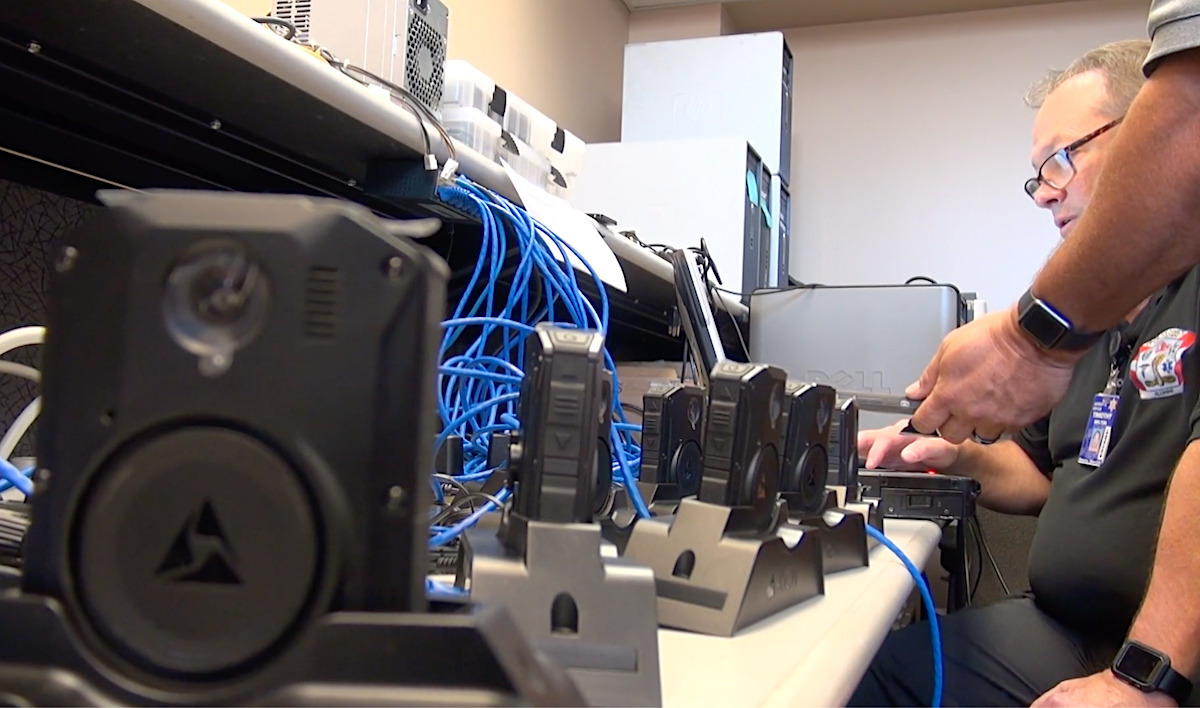
As Edmond was putting body cameras in place, the police department had the advantage of already operating an in-house technology department and having experience with dash cams. That meant the city was familiar with storage and infrastructure pricing, which Younger said has cost the city about $1 million over two decades.
But in smaller or less affluent cities — and for those without in-house storage capabilities — these expenses can prevent even the most enthusiastic departments from moving forward with body camera programs.
A 2018 report by the Police Executive Research Forum titled Cost and Benefits Of Body-Worn Camera Deployments found that, for most agencies, the cost of body cameras can be quite low — approximately $5,000 a year or less. However, the costs are low because most police departments either have a small number of officers or deploy cameras on only some of their officers. For large, fully equipped agencies, costs reach millions of dollars.
According to the study, many police departments appear to believe the benefits of body cameras outweigh the costs. The report found that more than one-third of American law enforcement agencies had already deployed body cams to some or all of their officers, and another 50 percent had plans to do so. It also found that a large majority of departments with body cameras are happy with them, and more than 85 percent would recommend them to other police agencies.
“Importantly, we found that the most important reason given for adopting BWCs, by over nine in 10 agencies, was to promote accountability, transparency, and legitimacy,” the report concluded. “This objective, which demonstrates a strong desire among agencies to build trust and foster relationships with their communities, is laudable.”
In May, the Oklahoma City Police Department created a digital media team to help expedite the release of videos requested under the Oklahoma Open Records Act. Since the team became operational, the department has released videos within five business days of the request, said Mark Myers, digital media specialist for OKCPD.
In June, the OKCPD Chief Wade Gourley announced his department would release body-worn camera footage for “critical” incidents within 10 days, a change sought by local activists who argued the agency was avoiding public scrutiny.
When and how exactly body-worn cameras should be activated is another question law enforcement agencies must address. Police departments have to develop policies determining whether body cams are used at every traffic stop or only in situations with elevated risk.
Edmond’s policy was put in place after much discussion, Younger said. EPD’s policy directs personnel to use the devices whenever possible or practical to record events, including but not limited to crimes in progress, enforcement actions, suspicious or domestic incidents, any contact that could be volatile, or any other contact or situation where the employee believes a recording would be appropriate or valuable.
“I think it is important for the public to understand that activation of camera technology is important, but the safety of citizens and officers should always come first. Some of the biggest fans of this technology are the officers that are wearing them,” Younger said. “Video frequently shows the complexities associated with this type of public service, as well as the uncertainty and rapidly evolving nature of many citizen contacts.”
Younger noted that a city’s police department often must come to agreements on body-worn camera policies with applicable police unions through collective bargaining agreements. (For instance, OKCPD and the Fraternal Order of Police Lodge 123 spent much of 2016 negotiating body-worn camera policies in arbitration to settle a variety of disagreements.)
“We were fortunate that we had 20 years to get used to how to utilize this type of technology and, we have a very engaged and proactive collective bargaining group,” said Younger, the Edmond chief. “We were able to learn from some of our metro regional partners on the processes they use to implement this technology. We were able to develop a policy that we feel addresses community expectation and is reasonable from the performance of an officer and their duties.”
Oklahoma County’s new cameras, meanwhile, come with a device that is designed to automatically begin recording when a weapon is drawn.
As with any technology today, these systems can also be hacked, as happened to the Tulsa Police Department’s data storage system in May.
Do body cameras actually work?

Of course, the growing presence of body cameras in U.S. law enforcement agencies has only highlighted instances of questionable or excessive force by police. It has not eliminated them, which has led some to ask whether the millions of taxpayer dollars spent on body cameras have provided the accountability and transparency expected.
In the past year alone, 941 people have been shot and killed by police in the U.S. According to a 2019 investigation by The Washington Post, “police nationwide [had] shot and killed almost the same number of people annually — nearly 1,000” in each of the preceding four years.
The newspaper’s database of fatal police shootings showed 14 unarmed Black victims and 25 unarmed white victims shot during interactions with police in 2019. The database does not include those killed by other means, like George Floyd. The states with the highest rates of shootings are New Mexico, Alaska and Oklahoma.
While the numbers are dire, some argue more context is needed.
“When compared to the Washington Post estimate of 990 deaths from police use of force in 2015, this number pales in comparison to 9,704 to 14,703 deadly weapon assaults against officers,” Richard R. Johnson wrote in a July 2016 report for the Dolan Consulting Group, a police training organization. “These numbers reveal that hundreds of times each year police officers show restraint in the face of dangerous assaults and do not kill their assailants even when they may be legally justified in doing so. Based on the 9,704 known deadly weapon assaults and the estimate of 990 deaths from police use of force, only one citizen death occurred for every 10 deadly weapon attacks on officers.”
A study published in 2019 by George Mason University’s Center for Evidence-Based Crime Policy suggests that the use of police body cameras has not had a significant effect on the behavior of either law enforcement or the public.The study collected data from 70 other body-worn camera studies, which showed that conclusions about use of force by police wearing cameras are a mixed bag. Five studies indicated that police who wore cameras used less force, but another eight studies found no statistical difference in the use of force.
Another study, released in March by the University of Chicago Crime Lab Council on Criminal Justice’s Task Force on Policing, found a drop in the use of force by police who wear body cameras, but it found an even larger drop in the number of citizen complaints when a law enforcement agency implements body cameras. It also found the cameras to be extremely cost effective in the long run.
“Our analysis suggests the ratio of benefits to society from adoption of BWCs to the costs is in the order of five to one,” the paper concluded. “If our analysis is correct, this implies that from society’s perspective this is the equivalent of the ability to turn a $1 bill into a $5 bill.”
Follow @NonDocMedia on:
Activists question effectiveness

Still, activists and concerned citizens question whether body cameras are really providing transparency and accountability.
In Edmond, citizen and private investigator Shaun Hittle has argued that body cameras alone are insufficient, and he has pushed for some sort of citizen oversight committee to work with the Edmond Police Department.
“Are body cams doing what they’re designed to do? We have no idea,” Hittle said. “I would have no idea whether or not interactions changed. I’m not aware of any instance where the body camera footage and interactions with the public are public. What’s really the point if no one is able to review this footage?”
Cities like Oklahoma City are taking steps to make body camera footage more accessible to the public, albeit after scrutiny. The updated OKCPD body-cam policy came into effect after 21CP Solutions, a consulting firm working with OKC Mayor David Holt’s police reform task force, suggested reducing the time it took to release videos from officer-involved incidents. Gourley said the move, which took effect July 1, was intended to “further promote openness and accountability” and that the department “is committed to providing the objective information concerning these critical incidents.”
RELATED
Oklahoma City tries, once again, to fix police oversight by Andrea DenHoed
Sara Bana, executive director of Civic Services Community Advocacy in OKC, has been involved in discussions about police oversight and police accountability for nearly a decade.
“The body cameras are something that I have a lot more experience with than I wish I had,” Bana said. “I’m only 37 years old, and when I began working with community policing efforts and police accountability work, one of the layers of that work required watching many of these videos that involve lethal police shootings. And so in the last 10 years, I’ve had experience watching traumatizing footage — images that you cannot forget once seen.”
Bana said that while body cams are not the end-all-be-all to improve police accountability, they constitute a vital step toward a more transparent relationship between the public and the police.
Like many activists, Bana is concerned about the ability of law enforcement to release partial or redacted videos. While media members and the public can file open records requests, departments can withhold or redact video being used for an investigation.
“I know that the (Oklahoma City) Police Department has now begun a whole new practice of putting out these public information videos where they take portions of body (camera) footage and narrate over the video,” Bana said. “In a world of police transparency and police accountability, that would be considered a tampered video. You want the untampered video as is without any remuneration. Conflict is even further escalated when you don’t release the entirety of the footage and you want to narrate over it as well.”
Bana said she would like to see a statewide law guaranteeing the public’s right to see unedited body cam video.
“Right now, body cams are the only tool that has documented and exposed killer cops and gives us the evidence necessary to hold the district attorneys accountable to do their job, which sometimes means filing criminal charges,” Bana said. “I think we, as a nation, must recognize that we are having an epidemic with the number of Americans being killed by their own law enforcement officers. We also have the responsibility and duty in making sure that, when Americans are killed, their loved ones have immediate access to the footage.”
Prater, Oklahoma County’s district attorney, said it took at least a year’s worth of negotiations with the OKC Fraternal Order of Police to hash out the wearing of the body cams and how they are used. The negotiations also led to officers being able to view their body camera footage after an incident.
After OKCPD officers shot and killed Bennie Edwards in December 2020, Prater said the agency released only snippets of footage that showed one moment — when Edwards was running at an officer — but not the subsequent footage of when Edwards was running away and was shot by a second officer, who was charged.
“With body cams, you have to watch and listen to everything in its entirety and in context, just like the rest of life,” Prater said. “Whatever you pull out of context is not going to make a whole lot of sense, and it may look like something completely different than what it truly is. When I have police departments who release only snippets to try to justify an officer’s actions, that’s really upsetting to me because that is not the transparency that we owe our public. It should not be edited, it should not be cut up. The audio should not be altered.”










